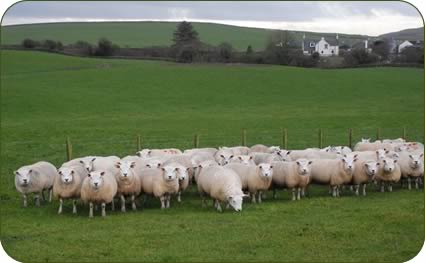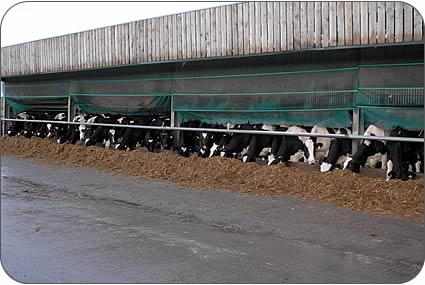Jennifer MacKenzie is an agricultural photo journalist with almost 30 year's experience. Operating from her base in Cumbria, Jennifer undertakes mainly industry-related freelance writing and photography.
Hobby proves to be valuable enterprise
Pedigree Texel sheep flocks founded almost 20 years ago as a hobby have
proved a valuable enterprise alongside a pedigree dairy herd for a Scottish
farming family.
The 417 acre Rascarrel Farm, which lies on the shores of the Solway Estuary
at Auchencairn, near Castle Douglas, has been farmed by the same family
for 44 years.
Tommy and Fiona MacTaggart now run the farm having taken over from Fiona’s
parents Jim and Ellice Hendry who continue to be in the partnership.
The family employs two full-time workers, tractorman Brian Wilson who has
worked at Rascarrel for 13 years, and dairyman Derek Graham, whose predecessor
Jim McFern was employed for 21 years.
 |
| The Rascarrel team - left to right,
Matthew MacTaggart, Fiona MacTaggart, Brian Wilson, Derek Graham and Tommy MacTaggart with the milking cows. |
Traditionally a dairy farm, the Texel flocks were set up in 1989 –the
company’s flock bears the Rascarrel prefix while Fiona, son Matthew,
18, a student in rural enterprise and land management at Harper Adams University
College, and triplets Ewan, Tom and Rebecca, 12, own the Auchencairn flock.
Established from 11 foundation females, there are now 85 ewes between the
flocks which have been built up using mainly home-bred ewes which are run
alongside the Rascarrel pedigree Holstein Friesian herd of 180 cows.
“Other than wintering sheep, we had never had any sheep on the farm.
I had always been involved with sheep through the family haulage company
and my brother has pedigree Texels,” said Tommy, who for six years
has been a director of the Texel Sheep Society and is immediate past chairman
of the Solway and Tyne Texel Club.
“We liked the Texel because of its carcase, tremendous muscle and
its ability to produce a modern export lamb. We have always bred the sheep
for their commercial attributes, including carcase, skins and growth, aiming
for the commercial market and if we are fortunate enough to get a breeder’s
sheep then that’s an added bonus.”
“What started as a hobby has grown into part of the business,” he
added.
The foundation ewes were bought from well-established flocks – two
each from the Gaitskill, Stonefieldhill and Cambwell flocks and five from
the Pergil flock.
Since then, only three females have been purchased for the Auchencairn
flock from the Carlisle in-lamb sale and four females for the Rascarrel
flock. The flock is MV and EA accredited.
The flock earned a reputation in the show ring with a home bred ewe by
Baltier Wizard winning the breed championship at the Royal Show in 1997
and the breed and interbreed championships at Dumfries Show in the same
year.
Since then ram lambs have been sold to 12,000gns at the Carlisle September
2006 sale for Rascarrel Masterpiece. The same year, shearling rams sold
to 4,600gns and an average of £1,535 for eight, marking one of the
best years for the flocks.
Females have sold up to 7,500gns to Procters Farms, Slaidburn, Clitheroe,
and manager Gary Swindlehurst returned to buy more females privately. Most
are sold through the ring at Carlisle, Lanark, Worcester, Builth Wells
and Castle Douglas pedigree sales.
“In 2007 we had an exceptional year considering the disruptions caused
by foot and mouth,” said Tommy.
“Our best price was for a ram lamb which sold for 3,400gns to the
Stonebridge flock at the Worcester sale. We also sold a ram lamb at Lanark
for 2,500gns to the Campbells, of Thrunton. We averaged £600 for
shearling rams at Carlisle with a top of 900gns and females sold up to
3,400gns.”
 |
| Texel Ewe Lambs |
In the flocks’ early days one of the first sires Cambwell Uplift
had a great influence in establishing the females lines. Subsequently,
Turin Estonian put more bone and carcase quality into the flock and Kelton
Young Gun, a son of Annan Vigour, also had a big impact on the females
coming into the flocks.
Then followed Baltier Wizard and Stonebridge Fantastic, the latter unfortunately
being taken in the contiguous cull of 2001 on the farm of the joint owner.
The advent of the National Scrapie Plan had a regressive influence on the
type of sheep the MacTaggarts were aiming to breed, with only a small pool
of Group 1 rams to buy in the first few years of the scheme to improve
the flocks’ ewe genotypes, 60 per cent of which at the time were
Group 3.
Cambwell Impressive and Tophill Jewel helped improve the genotypes and
more recently Douganhill King, a son of Jersey Dudeck have had a large
impact on the sale of ram lambs and females.
Stock sires for this year’s lambs – 20 ram lambs are sold each
year - are Templand Megane and Hullhouse Northern Light, which is jointly
owned with Jennifer and Geoff Aiken. All the ewes are in lamb to these
to sires as well as Douganhill King. There are also some embryos to lamb
to Glenside King.
The dairy herd was upgraded to pedigree 14 years ago and cow numbers over
recent years have increased from 120 to 180 cows.
Seventy per cent of the herd is put to the black and white bull with the
remainder to the British Blue and Limousin. All crossbred cattle and pure
bred steers are finished on the farm and sold deadweight.
The herd has a rolling average production of 8,800 litres at 4per cent
butterfat and 3.3 per cent protein even though 60 heifers have been brought
into the herd this year to increase numbers, with the milk selling to Milk
Link, of which Tommy was a council member until August 2007.
Holstein Friesian sires are selected for their feet, udders and longevity
as well as low cell count – the herd’s is currently running
at between 80 and 145 SCC and milk sold is consistently in premium band
A.
 |
The current Genus sires used are Drake, Shottle, Degas, Reece, Modesto
and Homestead. A stock bull, Gornall Tiptop, is used on the heifers.
Heifers calve at a target age of 30 to 32 months old. The MacTaggarts have
tried calving heifers earlier but found them easier to get back in calf
and retain body condition if left later as well as improving longevity
which is high for the herd.
The cows are split into four groups and fed a total mixed ration. The groups
are high yielders which are fed 6kg of a blend of soya, beet pulp, wheat
and barley grains; middle yielders get 4kg of the blend with it reduced
to 2kg for cows which are low yielders. The blend is mixed with grass silage
and some straw.
Cereals are grown on between 35 and 50 acres for home use as part of the
re-seed rotation. A further 35 acres of coastal land is a SSSI.
The cows are milked in a Fullwood 16x16 parlour installed eight years ago
and they are topped up with up to 8.5 kg of cake at a rate of 0.35kg per
litre. High yielders are fed at M plus 22 litres, medium yielders at M
plus 18 litres and low yielders at M plus 16 litres.
Dry cows are fed silage and straw and are also fed cobs from 35 days prior
to calving.
Heifers are fed with the cow groups but are topped up at M plus 15 litres
to encourage growth and maintain body condition when competing with older
cows.
Cattle and sheep are all computer recorded and the herd’s nutrition
is handled by Carrs Billington and Tarff Valley.

